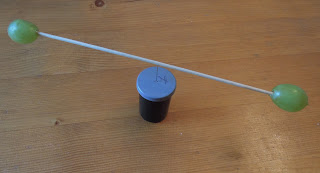If you want to try this yourself..
You'll need:
- 2 grapes
- A wooden skewer (NOT A STEEL ONE)
- A pin
- Something to stick the pin through so that it points upwards on a stable base. I used an old film canister, but bit of cork would do just as well.
- A neodymium magnet. The stronger the better but you probably want one with at least 20 Kg pull.

Safety:
THIS IS REALLY IMPORTANT
The neodymium magnets are really powerful. So...
- Don't let kids play with them.
- Don't put them near your credit cards, phone, watch or any other electrical equipment.
- Don't put 2 magnets anywhere near each other because they'll fly towards one another, shatter and send chunks flying.
- If you have any medical implants don't go anywhere near them.
- Read the safety instructions that come with the magnets.
What to do:
1. Push the 2 grapes onto either end of the skewer
2. Push the pin through the cap of film canister, so that its pointing upward. Put the cap back on the canister.
3. This is the tricky but. You need to balance the skewer and grapes on the point of the pin. If you get close then adjust the balance by pushing one grape further onto the skewer.
4. Once you've managed that just put the edge of the magnet near one of the grapes and watch them spin.
What's going on?
There are actually numerous types of magnetism. At school we only learn about ferromagnetism. Then there's paramagnets (which are attracted to ferromagnets) and diamagnets (which are repelled by ferromagnets). These 2 types of magnetism are much weaker than ferromagnets so you generally can't see the effect. Which is why you need a set up like this and a powerful magnet to observe it.
Since the water in the grape is diamagnetic its repelled by the strong ferromagnet near it and that makes the grapes spin on the pin.
You can demonstrate the same principle another way shown here.
Incidentally this effect is central to how MRI scanners in hospitals work.





